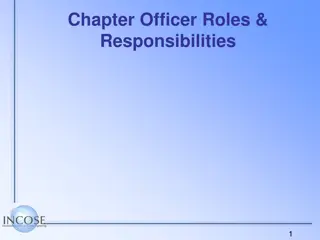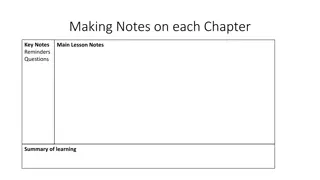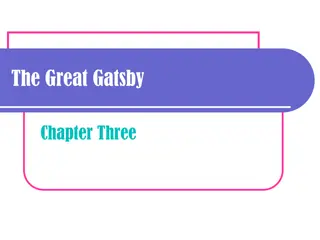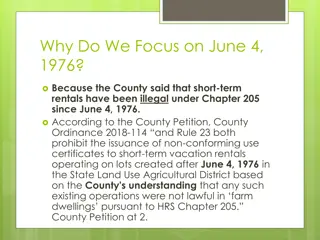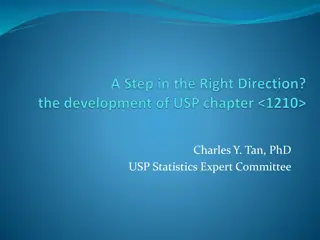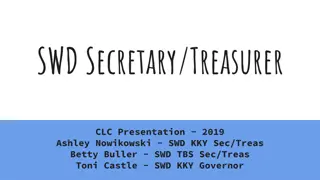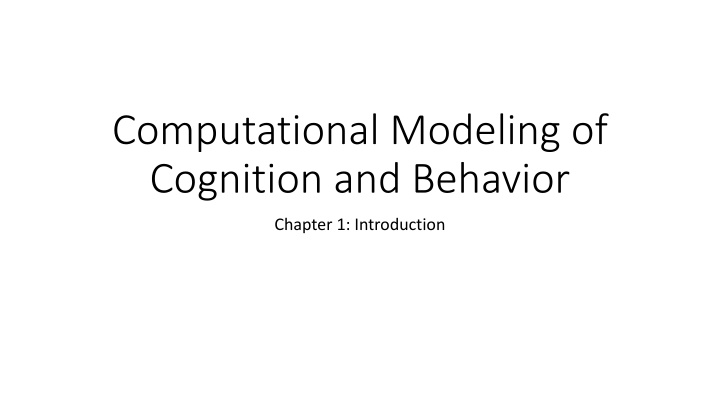
Modeling Cognition and Behavior: Introduction and Quantitative Approaches
Explore the importance of mathematical modeling in understanding human behavior and cognition. Discover how models in science provide insights into decision-making and classification processes. Delve into quantitative methods used to analyze and predict human behavior based on stimuli similarities.
Download Presentation

Please find below an Image/Link to download the presentation.
The content on the website is provided AS IS for your information and personal use only. It may not be sold, licensed, or shared on other websites without obtaining consent from the author. If you encounter any issues during the download, it is possible that the publisher has removed the file from their server.
You are allowed to download the files provided on this website for personal or commercial use, subject to the condition that they are used lawfully. All files are the property of their respective owners.
The content on the website is provided AS IS for your information and personal use only. It may not be sold, licensed, or shared on other websites without obtaining consent from the author.
E N D
Presentation Transcript
Computational Modeling of Cognition and Behavior Chapter 1: Introduction
Models in Theories and Science Describe and predict people s behavior Reliance on mathematical models just like physicists or chemists Data require a model to be understood and explained Verbal theorizing cannot substitute for quantitative analysis Must always select from several possible models Modelers must rely on intellectual and scholarly judgment, in addition to quantitative evaluation. Psychological plausibility, parsimony, falsifiability
Quantitative Modeling in Cognition Nosofsky, 1991 classified cartoon faces into one of two categories Made classification as well as recognition decisions
Quantitative Modeling in Cognition Appears to be no correlation between recognition and classification confidence. But Nosofsky s Generalized Context model (GCM) can predict both
Quantitative Modeling in Cognition To model these data, the stimuli were first sorted along four dimensions using multidimensional scaling (Kruskal, Young, & Seery, 1973) The dashed line indicates the bound between the circle and triangle categories. Sometimes the first step in modeling is to simply get the data into a quantitative form.
Quantitative Modeling in Cognition In the GCM, stimuli that are closer to each other are more similar. A simple distance formula is used to determine similarity.
Quantitative Modeling in Cognition Distance follows Shephard s (1987) generalization gradient (or law). The discriminability between two stimuli increases exponentially
Quantitative Modeling in Cognition The probability of classifying a stimulis into category A is determined by the summed similarity of that stimulus to category A stimuli. Nosofsky (1991) uses summed similarity in a slightly different way for classification and recognition choices.
Quantitative Modeling in Cognition Activation, based on summed similarity, from the GCM could predict both categorization and recognition probabilities.
Descriptive Models One main distinction between modeling approaches is whether the models are used to describe data, such as by comparing differences between groups. Or, whether models are being used to represent theories about cognitive processes. Heathcote et al. (2000) Power law does not describe data as well as exponential law of skill acquisition. Descriptive models have no intrinsic psychological content.
Cognitive Process Models The GCM is a cognitive process model. Doesn t just describe data Makes theoretical claims about how stimuli are perceived (Shephard, 1987) Claims that categorization is an exemplar process not a prototype of rule- based process. Claims that people can selectively attend to one dimension. Also claims that people use summed similarity, rather than average similarity.
Potential Problems: Scope and Falsifiability A model should have just the right scope Can predict the pattern of the data But, cannot predict every pattern. Particularly true for cognitive process models. Models need to be falsifiable, or testable.
Modeling as a Cognitive Aid for the Scientist Models help us communicate in specific ways Similarity or activation or selective attention can mean different things if only words are used. A model gives us precise operational definitions. Models can also be used to make specific predictions Using models as a tool can help us go beyond mere verbal theorizing, which is less precise.
Homework for Chapter 1 Will be examining how the exemplar model makes predictions about how likely it is each stimulus will be correctly classified.
Model Data Sets and Code BasicRLModels_SGT Fits many models for tasks like the IGT and SGT fit to Don et al., 2022 NBA data Byrne_etal2020 Fits Basic two choice RL models also uses regressors in multilevel models Cornwall et al., 2022 Fits and simulates ALCOVE, connectionist model of category learning Don et al., 2019 Fits models to the ABCD task used to test predictions of Delta vs. Decay RL models Don & Worthy 2022 follow-up to 2019 Don et al. paper

